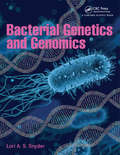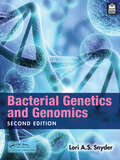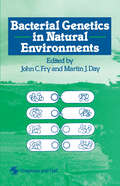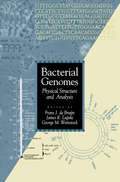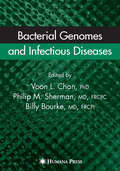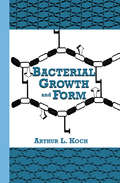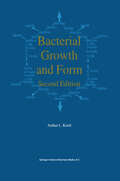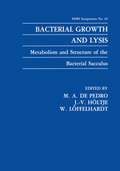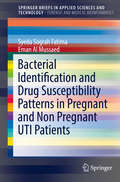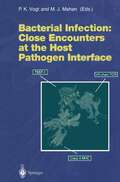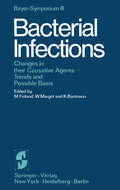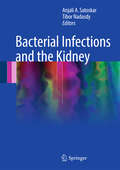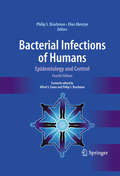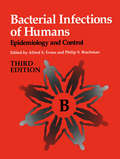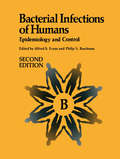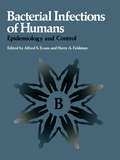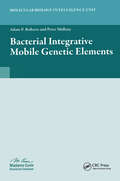- Table View
- List View
Bacterial Genetics and Genomics
by Lori A.S. SnyderOur understanding of bacterial genetics has progressed as the genomics field has advanced. Genetics and genomics complement and influence each other; they are inseparable. Under the novel insights from genetics and genomics, once-believed borders in biology start to fade: biological knowledge of the bacterial world is being viewed under a new light and concepts are being redefined. Species are difficult to delimit and relationships within and between groups of bacteria – the whole concept of a tree of life – is hotly debated when dealing with bacteria. The DNA within bacterial cells contains a variety of features and signals that influence the diversity of the microbial world. This text assumes readers have some knowledge of genetics and microbiology but acknowledges that it can be varied. Therefore, the book includes all of the information that readers need to know in order to understand the more advanced material in the book.
Bacterial Genetics and Genomics
by Lori Snyder Lori A.S. SnyderUnderstanding of bacterial genetics and genomics is fundamental to understanding bacteria and higher organisms, as well. Novel insights in the fields of genetics and genomics are challenging the once clear borders between the characteristics of bacteria and other life. Biological knowledge of the bacterial world is being viewed under a new light with input from genetic and genomics. Replication of bacterial circular and linear chromosomes, coupled (and uncoupled) transcription and translation, multiprotein systems that enhance survival, wide varieties of ways to control gene and protein expression, and a range of other features all influence the diversity of the microbial world. This text acknowledges that readers have varied knowledge of genetics and microbiology. Therefore, information is presented progressively, to enable all readers to understand the more advanced material in the book.This second edition of Bacterial Genetics and Genomics updates the information from the first edition with advances made over the past five years. This includes descriptions for 10 types of secretion systems, bacteria that can be seen with the naked eye, and differences between coupled transcription-translation and the uncoupled runaway transcription in bacteria. Topic updates include advances in bacteriophage therapy, biotechnology, and understanding bacterial evolution.Key Features Genetics, genomics, and bioinformatics integrated in one place Over 400 full-colour illustrations explain concepts and mechanisms throughout and are available to instructors for download A section dedicated to the application of genetics and genomics techniques, including a chapter devoted to laboratory techniques, which includes useful tips and recommendations for protocols, in addition to troubleshooting and alternative strategies Bulleted key points summarize each chapter Extensive self-study questions related to the chapter text and several discussion topics for study groups to explore further This book is extended and enhanced through a range of digital resources that include: Interactive online quizzes for each chapter Flashcards that allow the reader to test their understanding of key terms from the book Useful links for online resources associated with Chapters 16 and 17
Bacterial Genetics and Genomics
by Lori Snyder Lori A.S. SnyderUnderstanding of bacterial genetics and genomics is fundamental to understanding bacteria and higher organisms, as well. Novel insights in the fields of genetics and genomics are challenging the once clear borders between the characteristics of bacteria and other life. Biological knowledge of the bacterial world is being viewed under a new light with input from genetic and genomics. Replication of bacterial circular and linear chromosomes, coupled (and uncoupled) transcription and translation, multiprotein systems that enhance survival, wide varieties of ways to control gene and protein expression, and a range of other features all influence the diversity of the microbial world. This text acknowledges that readers have varied knowledge of genetics and microbiology. Therefore, information is presented progressively, to enable all readers to understand the more advanced material in the book.This second edition of Bacterial Genetics and Genomics updates the information from the first edition with advances made over the past five years. This includes descriptions for 10 types of secretion systems, bacteria that can be seen with the naked eye, and differences between coupled transcription-translation and the uncoupled runaway transcription in bacteria. Topic updates include advances in bacteriophage therapy, biotechnology, and understanding bacterial evolution.Key Features Genetics, genomics, and bioinformatics integrated in one place Over 400 full-colour illustrations explain concepts and mechanisms throughout and are available to instructors for download A section dedicated to the application of genetics and genomics techniques, including a chapter devoted to laboratory techniques, which includes useful tips and recommendations for protocols, in addition to troubleshooting and alternative strategies Bulleted key points summarize each chapter Extensive self-study questions related to the chapter text and several discussion topics for study groups to explore further This book is extended and enhanced through a range of digital resources that include: Interactive online quizzes for each chapter Flashcards that allow the reader to test their understanding of key terms from the book Useful links for online resources associated with Chapters 16 and 17
Bacterial Genetics in Natural Environments
by J. C. Fry M. J. DayThis book has arisen from the Second European Meeting on Bacterial Genetics and Ecology (Bageco-2) held at the University of Wales, College of Cardiff which we organised on 11-12 April 1989. The meeting was attended by some 60 participants from eight European countries and was made possible by partial financial support from the Commission of the European Communities (CEC) and Imperial Chem ical Industries (UK) Ltd. The meeting was organised to discuss modern developments in the genetics of bacteria in aquatic and terrestrial habitats. It followed on from, and complemented, the first meeting of this series organised by Jean-Pierre Gratia in Brussels during April 1987 which concentrated more on medical and epidemiological issues. ! The next meeting will be organised by Michel J. Gauthier in 1991 at Nice, France. If you have been fired with enthusiasm for ecological bacterial genetics after having read this book, and want to attend the next meeting but did not hear about the one in Cardiff, you should write to Dr Gauthier to be put on the address list. A lot is now known about bacterial genetics at the physiological, biochemical and molecular level, and bacterial ecology has developed rapidly over the last 20 years. However, until very recently, few researchers have crossed the divide and linked these two specialisms.
Bacterial Genomes: Physical Structure and Analysis
by Frans De Bruijn James R. Lupski G. M. WeinstockA wide range of microbiologists, molecular biologists, and molecular evolutionary biologists will find this new volume of singular interest. It summarizes the present knowledge about the structure and stability of microbial genomes, and reviews the techniques used to analyze and fingerprint them. Maps of approximately thirty important microbes, along with articles on the construction and relevant features of the maps are included. The volume is not intended as a complete compendium of all information on microbial genomes, but rather focuses on approaches, methods and good examples of the analysis of small genomes.
Bacterial Genomes and Infectious Diseases
by Ricky V. L Chan Philip M. Sherman Billy BourkeThe first bacterial genome, Haemophilus influenzae, was completely sequenced, annotated, and published in 1995. Today, more than 200 prokaryotic (archaeal and bacterial) genomes have been completed and over 500 prokaryotic genomes are in va- ous stages of completion. Seventeen eukaryotic genomes plus four eukaryotic chro- somes have been completed. The concept of achieving better understanding of an organism through knowledge of the complete genomic sequence was first demonstrated in 1978 when the first bacteriophage genome, X174, was sequenced. Complete genomic sequences of prokaryotes have led to a better understanding of the biology and evolution of the microbes, and, for pathogens, facilitated identification of new vaccine candidates, putative virulence genes, targets for antibiotics, new strategy for rapid diagnosis, and investigation of bacteria–host interactions and disease mec- nisms. Recent increased interest in microbial pathogens and infectious diseases is largely attributed to the re-emergence of infectious diseases like tuberculosis, emergence of new infectious diseases like AIDS and severe acute respiratory syndrome, the problem of an increasing rate of emergence of antibiotic-resistant variants of pathogens, and the fear of bioterrorism. Microbes are highly diverse and abundant in the biosphere. Less than 1% of these morphologically identified microbes can be cultured in vitro using standard techniques and conditions. With such abundance of microbes in nature, we can expect to see new variants and new species evolve and a small number will emerge as pathogens to humans.
Bacterial Growth and Form
by A.L. KochBased on the author's more than 40 years experience, Bacterial Growth and Form examines such important questions as what bacteria were, what they are, and what they do. Particular emphasis is placed on the ability of bacteria to establish their shapes as they grow and divide. By developing an understanding of the properties of these simple and early life forms, especially at the levels of physics and mathematics, the book provides insight into the mechanism used by bacteria to subvert physical forces to their own ends. A major consideration of this work is that prokaryotes do many of the same things that eukaryotes do, but with simpler equipment employed in an extremely sophisticated way. The book illustrates this point by closely examining the basic mechanismof hydrostatic or turgor pressure: how it functions for many of the mechanical purposes in the prokaryote, how it leads to mechanisms for resisting turgor pressure, and how it ultimately led to the development of exoskeletons and endoskeletons, and to the refinement of bacteria. Bacterial Growth and Form brings together biochemical, biophysical, and physiological principles in an authoritative, single-source volume. It provides researchers, and students in biophysics and microbiology with an indispensible reference and a new perspective into the biology of life.
Bacterial Growth and Form
by A.L. KochI assume that you already know a good deal of microbiology. In this book, I frequently use the word "we" by which I mean "you and I". Together we are going to consider bacteriology from a broader perspective and we will think our way through the important biological problems that are frequently just skipped over in every microbiology course. My most important reason for writing this book is to make accessible the relevant thinking from fields of science other than microbiology that are important to microbiology. The book is written for people that have already have a fascination with bacteria, but can see that their background for understanding is far complete. This book consists of topics that are largely omitted from microbiology textbooks and includes some mathematics, physics, chemistry, and evolutionary biology. It contains a good deal of my own work, both experimental and theoretical, together with a lot of speculation. If ten times bigger, it would be a full text book on microbial physiology. A third of the microbial physiology is covered by the recent is no longer treated even in textbook by White (2000). Another third current specialized tests and is greatly underrepresented in text books.
Bacterial Growth and Lysis: Metabolism and Structure of the Bacterial Sacculus (F.E.M.S. Symposium Series #65)
by M. A. De Pedro J. V. Höltje Wolfgang LöffelhardtThis volume is based on a FEMS Symposium entitled "Bacterial Growth and Lysis: Metabolism and Structure of the Bacterial Sacculus" held at the Monastery of Lluc (Mallorca, Spain) on 5-10 April, 1992. The goals of the symposium were to assess the present state of knowledge on the structure and physiology of the bacterial murein sacculus, and to develop new hypotheses and strategies to promote further development of the field. Consequently, the contributions compiled in this volume include broadly different approaches, from the introduction of new analytical methods to the presentation of provocative models for cell wall growth and division. Structural, biochemical, and genetic aspects are widely covered with special emphasis on the enzymology and regulation of murein hydrolases (autolysins). Comprehensive reviews on bacterial S layers and yeast cell walls are included to stimulate conceptual cross-feeding with these closely related topics. We believe that this book will provide the reader with a useful and up-to-date review of the topic. We would feel deeply rewarded by any positive influence this book may have on the future progress of the field, whereby all the scientific credit for it should be given to the authors of the excellent contributions presented.
Bacterial Identification and Drug Susceptibility Patterns in Pregnant and Non Pregnant UTI Patients (SpringerBriefs in Applied Sciences and Technology)
by Syeda Sograh Fatima Eman Al MussaedThis book provides a review of essential research on urinary tract infections (UTIs), as well as a broader perspective on methodologies adopted for the isolation and identification of the bacteria from urine samples of pregnant and non-pregnant women on the basis of their cultural, morphological and biochemical characteristics. The identification is extended to the strain level by means of molecular identification involving BLAST as a bioinformatics tool. The book also addresses the roles of various other bioinformatics tools for tracing the phylogenetic tree and conservation studies among the bacteriocin of the identified bacteria. Lastly, it assesses the antibiotics resistance patterns of these isolates.
Bacterial Infection: Close Encounters at the Host Pathogen Interface (Current Topics in Microbiology and Immunology #225)
by Peter K. Vogt Michael J. MahanWhen it comes to bacterial disease, we are living in a state of false security. Antibiotics have indeed brought unprecedented health benefits, protection from and cure of bacterial diseases during the past 50 years. But there are ominous signs that the fortress and the defenses built on antibiotics are crumbling. They are crum bling because we wittingly or unwittingly created selective con ditions for the emergence of superior pathogens that can no longer be controlled by antibiotics. There are numerous warnings. After a long period of eclipse tuberculosis has now emerged as a serious threat unchecked by antibiotic treatment. Recent years have seen reports of cholera epidemics, of anthrax infections, of serious problems with Salmonella and even with E. coli, just to name a few. Mankind is in a race with microbial invaders. The challenge is to anticipate and respond to developments that affect the precarious balance between man and microbe. This will re quire new knowledge and it will take time for an effective appli cation of that knowledge.
Bacterial Infections: Changes in their Causative Agents Trends and Possible Basis (Bayer-Symposium #3)
by M. Finland W. Marget K. BartmannBacterial Infections and the Kidney
by Anjali A. Satoskar Tibor NadasdyThis text is designed to present a comprehensive and state-of the-art but practical approach to the diagnosis and management of bacterial infection associated renal disease. The chapters address the different types of glomerular, tubulointerstitial and vascular diseases, associated with bacterial infections, describe diagnostic pitfalls, provide differential diagnosis and discuss treatment and management. Easy to follow diagnostic algorithms and tables are included for practical usefulness. The text provides a large number of color microphotographs, illustrations and each chapter refers to the most important up to date literature in the area. All chapters are written by experts in the field and will include the most up-to-date clinical information. A comprehensive but user friendly resource on renal complications of bacterial infection, such as this book, is overdue, particularly now in the era of staphylococcus epidemic and emerging new resistant bacterial strains. Bacterial Infections and the Kidney will be an important resource for pathologists, nephrologists, general internists, infectious disease specialists, and urologists. Transplant surgeons may find the chapter on transplant pyelonephritis very useful.
Bacterial Infections of Humans: Epidemiology and Control
by Elias Abrutyn Philip S. BrachmanIn Memoriam of Alfred S. Evans The third edition of Bacterial Infections of Humans is dedicated to Alfred Spring Evans, who died on January 21, 1996, 2 ½ years after a diagnosis of cancer. Al was the senior editor of this textbook, which he founded with Harry Feldman in 1982. Al was a clinician, epidemiologist, educator, ca- lyst for biomedical research, historian, author, speaker, seeker of the truth, sincere friend of students, sports enthusiast, traveler, and truly a man of all seasons. He was a devoted husband to Brigette Klug Evans, father of three children, and grandfather of four. Al was born in Buffalo, New York, on August 21, 1917, to Ellen Spring and John H. Evans, M. D. , one of the United States’s ?rst anesthesiologists and an early researcher in the ?eld of oxygen therapy. He received his undergraduate training at the University of Michigan; was awarded an M. D. degree in 1943 from the University of Buffalo; interned in Pittsburgh, Pe- sylvania; and performed his medical residency at the Goldwater Hospital in New York City. He was in the United States Army from 1944 to 1946, assigned as a public health of?cer to a base in Okinawa, Japan. It was there that he met Drs. Albert Sabin and John R. Paul, who came to Okinawa to test a new Japanese encepha- tis vaccine. Al was invited by Dr. Paul to come to Yale Alfred S.
Bacterial Infections of Humans: Epidemiology and Control
by Philip S. Brachman Alfred S. EvansIn Memoriam of Alfred S. Evans This third edition of Bacterial Infections of Humans is dedicated to Alfred Spring Evans, who died on January 21, 1996, 2Yz years after a diagnosis of cancer. Al was the senior editor of this textbook, which he founded with Harry Feldman in 1982. Al was a clinician, epidemiologist, educator, catalyst for biomedical research, historian, author, speaker, seeker of the truth, sincere friend of students, sports enthusiast, traveler, and truly a man of all seasons. He was a devoted husband to Brigette Klug Evans, father of three children, and grandfather of four. Al was born in Buffalo, New York, on August 21,1917, to Ellen Spring and John H. Evans, M.D., one ofthe United States's first anesthesiologists and an early researcher in the field of oxygen therapy. He received his undergraduate training at the University of Michigan; was awarded an M.D. degree in 1943 from the University of Buffalo; interned in Pittsburgh, Pennsylvania; and performed his medical residency at the Goldwater Hospital in New York City. He was in the United States Army from 1944 to 1946, assigned as a public health officer to a base in Okinawa, Japan. It was there that he met Drs.
Bacterial Infections of Humans: Epidemiology and Control (pdf)
by Philip S. Brachman Alfred S. EvansBacterial Infections of Humans: Epidemiology and Control
by Alfred S. Evans Harry A. FeldmanThis is a companion volume to Viral Infections of Humans: Epidemiology and Control. The apparent success of that book in bridging the gap between texts on basic microbiology and those on clinical infectious diseases led to editing this one on bacterial infections, the chapters of which are organized in exactly the same format of 12 units: introduction, historical background, methodology, biological characteristics of the organism, descriptive epidemiology, mechanisms and routes of transmission, pathogenesis and im munity, patterns of host response, control and prevention, unresolved problems, references, and suggested reading. The purpose of this book is to provide a description and understanding of the pathogenesis of infection and disease both within the community and within the individual. This is done in the belief that a variety of factors in both the external and the internal environment, and in the nature of the infectious agent, influence exposure, the development of infection, and the pattern of the host response. An understanding of the epidemiology and pathogenesis of these processes forms the basis for approaches to control and prevention. The first two chapters of this book deal with general epidemiological concepts and with surveillance.
Bacterial Infections of the Central Nervous System (ISSN #Volume 96)
by Karen L. Roos Allan R. TunkelBacterial Infections of the Central Nervous System aims to provide information useful to physicians taking care of patients with bacterial infections in the central nervous system (CNS), which can lead to morbidity and mortality. The increased number of patients suffering from this infection has led to the development of vaccines and antibiotics. Comprised of four chapters, the book explains the general approach to patients with bacterial CNS infection. It also discusses various CNS infection concepts and terms. These include the characteristic neuroimaging appearance of specific bacterial infections, the limitations of neuroimaging, the cerebrospinal fluid analysis, the pathogenesis and pathophysiology of bacterial CNS infections, the developments of specific adjunctive strategies, and the principles of antimicrobial therapy. It also includes discussions on various diseases that target the CNS, such as meningitis, focal CNS infections, neurological complications of endocarditis, suppurative venous sinus thrombosis, infections in the neurosurgical patient, and CNS diseases caused by selected infectious agents and toxins. This book will serve as a guide for clinical physicians who have patients suffering from bacterial CNS infection. Valuable insights into the pathophysiological mechanism of bacterial CNS infections A multidisciplinary reach that provides critical information for neurologists, neurosurgeons, and specialists in infectious disease Considerable information and emphasis on new diagnostic techniques and laboratory testing
Bacterial Integrative Mobile Genetic Elements
by Adam P. Roberts Peter MullanyAs our understanding of mobile genetic elements continues to grow we are gaining a deeper appreciation of their importance in shaping the bacterial genome and in the properties they confer to their bacterial hosts. These include, but are by no means limited to, resistance to antibiotics, and heavy metals, toxin production and increased virulence, production of antibiotics and the ability to utilize a diverse range of metabolic substrates. We are also gaining an understanding of diversity of these elements and their interactions with each other; a property which continually complicates any attempt to classify them. We are learning more about the molecular mechanisms by which they translocate to new genomic sites both within genomes and between different bacteria. This book provides a timely, state of the art update on the properties of an important selection of different bacterial integrative mobile genetic elements and the myriad of different ways in which they move and influence the biology of the host bacterium. The chapters are all written by authors who have undertaken pioneering work in their respective fields, making this book vital reading for all who are interested in the biology of bacteria and the mobile elements they carry.
Bacterial Integrative Mobile Genetic Elements
by Adam P. Roberts Peter MullanyAs our understanding of mobile genetic elements continues to grow we are gaining a deeper appreciation of their importance in shaping the bacterial genome and in the properties they confer to their bacterial hosts. These include, but are by no means limited to, resistance to antibiotics, and heavy metals, toxin production and increased virulence, production of antibiotics and the ability to utilize a diverse range of metabolic substrates. We are also gaining an understanding of diversity of these elements and their interactions with each other; a property which continually complicates any attempt to classify them. We are learning more about the molecular mechanisms by which they translocate to new genomic sites both within genomes and between different bacteria. This book provides a timely, state of the art update on the properties of an important selection of different bacterial integrative mobile genetic elements and the myriad of different ways in which they move and influence the biology of the host bacterium. The chapters are all written by authors who have undertaken pioneering work in their respective fields, making this book vital reading for all who are interested in the biology of bacteria and the mobile elements they carry.
Bacterial Invasion into Eukaryotic Cells: Subcellular Biochemistry (pdf) (Subcellular Biochemistry #33)
by Tobias A. Oelschlaeger Jörg H. HackerBacterial Invasiveness (Current Topics in Microbiology and Immunology #209)
by Virginia L. MillerIntracellular pathogens are responsible for a number of important diseases worldwide, including tuberculosis, plague and bacillary dysentery. This volume focusses on those intracellular pathogens that have been studied most extensively at the molecular, genetic, and cellular level. The reviews attempt to integrate the information derived from these diverse approaches into a cohesive picture. In recent years the entry steps have been described at the molecular and genetic level, and the important signal transduction events are being elucidated. It is now becoming clear that there are both similarities and differences both in terms of the steps involved and of the genetic basis of bacterial invasiveness. These reviews of the "state of the art" provide a foundation from which to proceed.
Bacterial Lipopolysaccharides: Structure, Chemical Synthesis, Biogenesis and Interaction with Host Cells
by Yuriy A. A. Knirel and Miguel A. A. ValvanoThe bacterial lipopolysaccharide also known as endotoxin is exhaustively covered in the present work. Central emphasis is placed upon the fine chemical structure of the lipopolysaccharide and its significance for understanding their activity and function. In particular, the role it plays in the interaction of bacteria with other biological systems is examined. New aspects of their physicochemical biology are introduced and updates to the current knowledge concerning the lipopolysaccharide are provided. This important class of biomolecules has recently attracted the attention of many investigators, in particular for understanding its involvement in innate immunity, toll-like receptor recognition and intracellular signaling.
Bacterial Membrane Vesicles: Biogenesis, Functions and Applications
by Maria Kaparakis-Liaskos Thomas A. KuferThis book focuses on the multitude of functions bacterial membrane vesicles perform in bacterial ecology and pathogenesis as well as in emerging medical and biotechnological applications. Both Gram-negative and Gram-positive bacteria produce membrane-bound nanostructures, known as membrane vesicles, which have a range of functions that include serving as delivery vehicles, providing a means of communication over both spatial and temporal scales, and contributing to bacterial survival and evolution. Topics covered in this book range from the biogenesis and composition of bacterial membrane vesicles to their abundance and biological roles in microbial ecosystems, such as marine environments. In the individual chapters, the involvement of bacterial membrane vesicles in host-pathogen interactions, promoting virulence and in facilitating the establishment of infection is explained. In addition, current knowledge regarding membrane vesicles produced by commensal bacteria and their role in the maturation of the host immune system, as well as the therapeutic potential of bacterial membrane vesicles as delivery systems and innovative nanotechnology-based therapeutics are discussed. This work appeals to a wide readership of students and researchers interested in microbial ecology, mechanism underlying pathogenesis and new avenues in applied microbiology and nanotechnology.
Bacterial Membranes and the Respiratory Chain (Biomembranes #6)
by N. S. Gel manThe most valuable service Dr. Gel'man and her colleagues have performed for the many investigators of bacterial membrane systems in producing their first excellent monograph on "The Respiratory Apparatus of Bacteria" in 1966 has been continued and expanded in the preparation of this volume. The au thors have brought together in a single volume much of the detail of investiga tions of bacterial membranes at the ultrastructura11eve1 and the chemical and biochemical organizationa11eve1s. The approach in bringing together this rap idly increasing volume of discovery has been both comprehensive and system atic, with a constant awareness of the importance of the molecular and func tional properties and relationships existing in various bacterial membranes. The monograph naturally reflects the authors' interest and their own inti mate involvement in the elucidation at the molecular level of the respiratory chains organized in the prokaryotic bacterial membrane system. It is entirely appropriate that the chapter devoted to this topic should occupy a substantial proportion of this monograph. Indeed, had this volume been prepared at this very moment, that proportion would have been even greater, as the work in .
